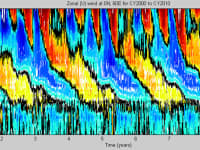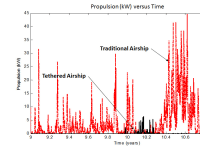Background and Motivation: Many missions would benefit from a stratospheric platform (or set of stratospheric platforms) that could remain stationary over, or close to, the Earth’s equator for extended periods of time: large aperture infrared telescopes; communications relays for equatorial regions (e.g., Indonesian archipelago); Earth observation. Airships are less expensive than satellites and can fly higher than traditional aircraft. However, despite billions of dollars invested (indicating market potential), there are no long-endurance airships capable of station-keeping in the stratosphere.
Manufacturability: All major elements in the concept are demonstrably within current state-of-the-art, although they have never been combined into a single system. All elements can be manufactured, integrated, and flown by a corporate team in Oregon and Washington State.
Finessing the Wind for Stratospheric Stationkeeping: Equatorial winds in the lower and upper stratosphere almost always go in opposite directions (Winds.jpg). Thus, two airships at different altitudes, connected by a long tether, should be able to equalize their respective drag forces and remain stationary with respect to the ground with essentially no energy cost. This would allow the airships to “spend more weight” on hull integrity (endurance) and payload.
Physical Design and Concept of Operation: Design.jpg illustrates the physical design and a typical flight profile. The lower airship carries the primary payload, designed for operation in a relatively narrow altitude range in the lower stratosphere. The upper airship is designed to operate over a range of altitudes; its primary burden is the tether along with the parachute and parafoil. It carries no propulsion. Its altitude is controlled primarily by managing tether length with a reel assembly on the lower airship. The embedded graph shows the two worst years of weather data from Winds.jpg. Red and blue traces illustrate altitudes of the upper and lower airship, respectively, managed by tether length. These altitudes come close to equalizing drag, but active drag reduction is also needed. Parachutes with adjustable vents or apertures equalize the drag. Parafoils add dynamic lift (upward for the upper airship; downward for the lower airship) so that forces tending to separate the airships vertically are greater than forces tending to separate them laterally. A small engine on the lower airship is available for periods of light wind. Performance.jpg shows traditional airship thrust in red and tethered airship thrust in black for this time period. There is a 20:1 reduction in average thrust; thus, high winds have been finessed. Note especially peak wind circa year 10.6, where the traditional airship needs up to 45 kW but the tethered airship needs almost no active propulsion. Conversely, the tethered airship occasionally needs slightly more propulsion in low wind – a good engineering trade. Considered overall, the tethered airship minimizes overall energy cost, translating into smaller batteries, solar arrays, and propulsion systems.
The tethered airship also overcomes the problem of run-away buoyancy, and offers potential for world-wide maneuvering. By opening and closing the parachutes, the system can maneuver east-west. By adjusting bank angle of the parafoils, north-south maneuvering and “loop trajectories” can be achieved.
Like this entry?
-
About the Entrant
- Name:Stephen Heppe
- Type of entry:individual
- Software used for this entry:Matlab
- Patent status:patented








